The Controversy Surrounding LGBTQ+ Cartoon Characters
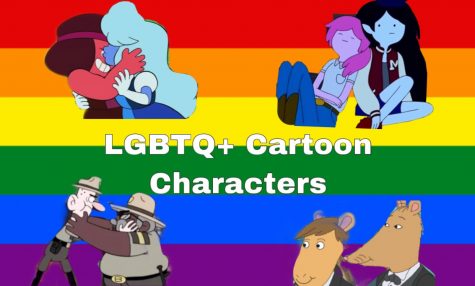
Nowadays, there is a growth in unique LGBTQ+ representation in animated children’s shows, giving a whole new generation spectrum of kids and adults the representation and visibility they need for their community.
Throughout the years, many creators of animated TV shows have expressed their support for the LGBTQ+ community through characters. Many are not spot on but with some research, the creators have revealed the persona behind these characters.
The controversial aspect surrounding having characters from the community is a topic that’s still debated to this day. Many families come from religious beliefs or are simply homophobic. Parents won’t allow their kids to watch these shows because they claim that it’s inappropriate to show a child.
Genieve Cuadra, a proud member of the LGBTQ+ community herself claims that it all follows on educating younger audiences and showing awareness of the community’s existence.
“I feel like this has changed many perspectives in the LGBTQ+ community, for example, many people now feel more represented through the shows and find ways to relate to these characters even when parents may not allow their kids to watch shows with queer characters, because they think it will influence their decisions regarding their sexuality or sexual orientation,” said Cuadra.
Emeli Garcia, an open member of the community herself claims that it’s a big step empowering for all of the community to have this representation on these platforms.
“Although being gay, trans, nonbinary, etc, is beginning to be normalized it continues to be a battle for all of us to be looked normal in this society,” said Garcia. “I feel like involving people like me in cartoons is going to help the newer generation view us as normal rather than look as “different” from other folks.”
A DVC anonymous student is a supportive ally to the community and believes that there should be a representation for the community, but there should be a limit on how creators portray and reveal the community to younger audiences.
“Including LGBTQ+ characters just shows kids the representation that we’ve been lacking, and that we aren’t as different as society wants us to be,” said anonymous. “I don’t agree with any portrayal of sex to young kids, from straight couples or LGBTQ+ couples, because that is where it is unacceptable for younger audiences. The representation doesn’t do any harm and really just educates kids about these people who just happen to love somebody “different.”
Garcia believes that the creator should have a limit for how much they show to younger audiences because it all has its limitations.
“I think that having these characters shouldn’t cross the line on revealing their sexual preferences because of the romantical romance that ties down with it,” said Garcia. “It isn’t okay for a child to watch that at such a young age, no matter even if you’re straight I don’t think shows should show romantic involvement with any gender.”
Many creators don’t directly let the audience know right away of the characters’ sexual preference or how one wishes to go by in the series. Most don’t reveal it until the end of the series or simply give off the hints for one to then decide what exactly the creators were indicating.
Some parents won’t allow their children to watch these shows because they believe their children will get the wrong idea and simply get influenced to be a part of the community. That’s where many creators of these animated shows get their Rotten Tomatoes reviews and other forms of criticism because they show a queer character in the show.
Jasmine Jiminez, a parent who thinks otherwise of allowing their child to watch a show with a queer cartoon character, has her own beliefs on what a child should see at such a young age.
“I think it’s too early to show a child someone from the community because they can be influenced and convince themselves into this community and a child doesn’t quite know what they want at such a young age,” said Mendez.
Jiminez Mendez thinks that the community should be represented but they should be aware of how they show it and have their limits on it.
“I think the community should have their representation but perhaps not having it all thrown at once at a child, possibly having a few amount episodes of these queer characters here and there, so they can acknowledge it, but at a distance, since they can’t really process these things,” said Mendez.
Cuadra thinks otherwise and believes that it isn’t inappropriate but something educational and empowering.
“I think it’s a smart way to help children become aware of the LGBTQ+ community and be educated on it and shouldn’t be seen as inappropriate,” said Cuadra.
Educating younger audiences about the community can be something that a child will not fully understand or comprehend. At such a young age, children begin to adapt their actions based on what’s around them. That’s where older audiences like parents believe they should be older enough to understand the community where they can make decisions for themselves.
DVC anonymous believes that parents often put fear ahead of themselves and use that fear to decide whether or not their child should be exposed to this new environment.
“It is unfortunate because of the fear of explaining something that is different or new to the family or the fear of exposure to something they don’t agree with or want the kids to be involved with,” said anonymous.
The controversy surrounding the aspect of having queer characters as a part of the animation industry will always seem to be a rough topic to be discussed. It will continue to be this way among generations with adult supervision and the way younger audiences perceive this new unfamiliar information.
Cartoon Characters Apart of the Community
Adventure Time: Cartoon Network, Marceline the Vampire and Princess Bubblegum
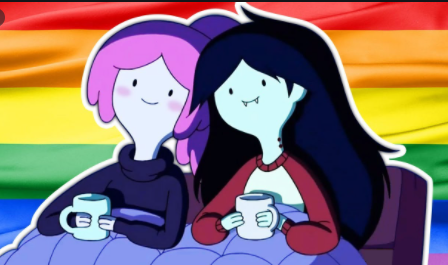
After eight years and ten seasons, Adventure Time had confirmed a long-anticipated relationship between Princess Bubblegum and Marceline where their relationship evolved from a hate-love relationship to a romantic relationship throughout the show. The creator’s first intentions were to create Marceline as a friend-enemy along with Princess Bubblegum. The creators changed the plot and added some development in the relationship between these two. Season eight is the season where these two characters began showing their true feelings for each other. It wasn’t till the episode “Hello, Bonnibel” where the creators had confirmed their relationship. They share a kiss towards the end of the episode after Marceline helps save Princess Bubblegum from being in danger.
Steven Universe: Cartoon Network, Ruby and Sapphire
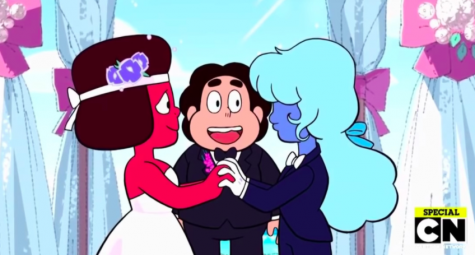
The exciting adventures of Steven and his friends with strong five-seasons the creators had shown their support with the LGBTQ+ community by touching difficult topics like homophobia, anxiety, and domestic violence throughout a series of characters. Steven and his adopted family of female warrior aliens “The Crystal Gems”. The creators weren’t afraid to reveal that most of the Gems characters were queer. The cartoon characters; Ruby and Sapphire get married in the episode “StevenBomb” where they get compromised in a queer marriage. The show had featured women in tuxedos, boys in dresses, and a non-binary person in whatever clothing they wanted, and all of it is celebrated throughout the seasons.
Gravity Falls: Disney Channel, Sheriff Blubs and Deputy Durland
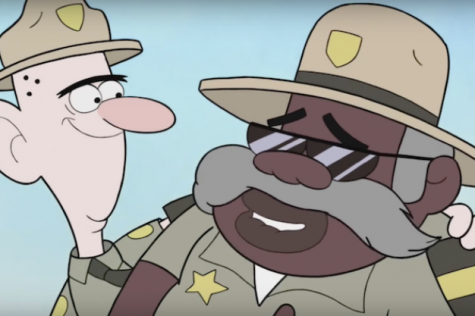
In the Adventures of Mabel and Dipper, the two main characters worked alongside each other were Sheriff Blubs and Deputy Durland throughout their two seasons. The creator Alex Hirsch of Gravity Falls addressed the queer characters in the series and stated in an interview “I would love to but I doubt they’d ever let me do it in kids T.V. But man I would if I could,” Hirsch says. The creator had left off the season finale where the sheriff saved the deputy and the two seem to appear to confess their love for one another while smiling, hugging, and embracing each other’s faces. The creator seemed to really want to show off these two queer characters their true love for one another but was afraid they wouldn’t let him air it out in a kid’s show. He left it off for the audience to have a gist of the relationship of the queer characters.
Arthur: PBS Kids, Mr. Ratburn
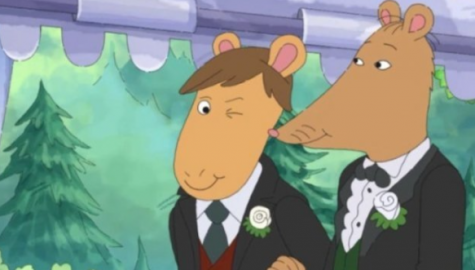
Arthur was an animated series that aimed at viewers ages four to eight and premiered 23 seasons based on the Arthur Adventure book series. The character Mr. Ratburn was openly gay throughout the series. In the episode of “Mr. Ratburn and the Special Someone,” on the 22nd season, the creators revealed his wedding with his husband Patrick and was noted to be one of the most controversial openings of a queer person on a kid’s show.
Claudia Brown • Nov 13, 2020 at 10:20 pm
Such a cool topic! LGBTQ+ rights are human rights.
Kei Theasult • Nov 13, 2020 at 1:54 pm
There are numerous issues involving lgbt cartoons.
To start with no ever once brought the issue out in the open for the public to weigh in on. The entire concept has been slammed in people’s faces from the start.
2. There is a World class psychiatrist from John Hopkins Medical center whose noted with data and studies that lgbt individuals tend to have psychological issues often convoluting their identity and sexuality.
3. When you factor in the magnanimity of the power of the Hollywood and Media and DNC Elite pedophiles who operate with abandon with all if the pedophile imagery in Walt Disney cartoons like the Lion King you cannot in good faith allow any said lgbt propaganda oriented at children.
Btw, “Pinnocho” is a film meant as a WARNING to children about the pedophile and evil nature of HOLLYWOOD as far back as the 1940!!